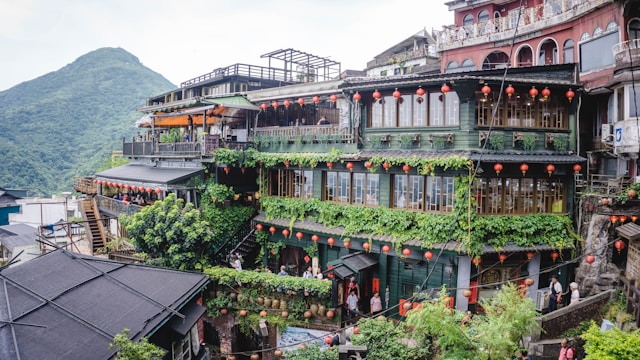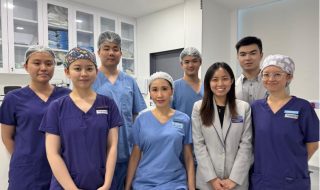
Taiwan Shopping Guide You’ll Actually Use
Taipei has a way of turning even casual visitors into devoted shoppers. My husband and I went for the food, but we quickly discovered how enjoyable it is to shop in the city, especially with the kindness of the people you meet at every turn. At the time of writing, one New Taiwan Dollar is roughly equivalent to 0.042 Singapore Dollar, which makes Taipei’s wide range of shopping choices friendly to all budgets. The city is more than a retail destination. It is a lively blend of culture, warmth, and irresistible finds.
One of the most charming ways to experience Taiwan is through its souvenirs and snacks. Pineapple cakes remain the country’s most iconic gift, and visiting specialty bakeries such as Chia Te Bakery or Taipei LeeChi feels like walking into a gallery of beautifully crafted pastries. Their pineapple and winter melon varieties are packaged elegantly, making them perfect to bring home. Tea lovers can enjoy the refined selections at Jing Sheng Yu on Yongkang Street, while Jiufen Old Street offers tea experiences in a setting that feels lifted from the world of Spirited Away. Its lantern-lined alleys and traditional structures create an atmosphere that is both nostalgic and cinematic.

Image Credits: unsplash.com
For anyone who loves characters and collectibles, Taipei feels like one big playground. Donguri Republic at Shin Kong Mitsukoshi in Xinyi brings Studio Ghibli favorites to life with shelves filled with Totoro and other well loved figures. Pokémon Center Taipei adds another layer of excitement with plush toys, trading cards, and exclusive items. The city is also famous for gashapon machines. Ximending alone features more than 500 of them, offering everything from anime figurines to cute and calming collectibles. Shilin Night Market has its own growing collection, while the malls in Xinyi scatter machines across several floors, turning an ordinary shopping trip into a series of small surprises.
Blind box collectors often gravitate toward Ximending, although some resellers charge two or three times the original price. Pop Mart Ximen is a better choice if you want to go straight to the source. The four storey space includes exhibition areas, a VIP lounge, and larger than life displays of Molly and other popular characters. Crowds tend to build during weekends, yet the experience is worth every moment. Nearby, the Wan Nian Building offers an entire structure dedicated to anime lovers. We found shops selling everything from Voltes V and Dragon Ball to Sakamoto Days and Spy x Family. The Taipei Animate Store is also in the area, with its own entrance tucked below street level and a nearby café that adds to the fun.

Image Credits: unsplash.com
Taipei’s markets reveal a different side of the city. Nanmen Market near the Chiang Kai Shek Memorial Hall focuses on traditional ingredients such as dried goods and fresh local produce. The Taipei Expo Farmer’s Market at Yuanshan MRT brightens weekends with honey, tea, fruits, vegetables, and small batch artisanal items. Red House Craft Market in Ximending highlights the creativity of local artists. The prices can be higher compared to other markets, but the atmosphere is enjoyable and supports independent makers.
Beauty and fashion are part of the city’s everyday charm. Pharmacy chains like Watsons and Cosmed carry cosmetics and skincare that suit a wide range of preferences, and Watsons often offers attractive discounts. For affordable fashion, Wufenpu near Raohe Night Market is a reliable stop. Its narrow lanes are filled with shops carrying clothes, sunglasses, accessories, and children’s items. Trendy and mid range boutiques are scattered throughout Ximending, Yongkang, Shida, and Gongguan, while NET provides a local version of GAP style basics. For a premium experience, Taipei 101 offers luxury brands and an observatory that makes the visit feel even more memorable.

Image Credits: unsplash.com
Shopping in Taipei never feels like a simple transaction. It feels like an invitation to explore the city’s creativity, history, and personality through the things you bring home. Whether it is tea from Jiufen, a blind box from Ximending, or a handmade craft from Red House, every purchase becomes part of your travel story.
Micro-investing: Small Money Big Momentum
Micro-investing has emerged as one of the most accessible ways for Singaporeans to enter the financial markets without the stress of committing large sums. The idea is straightforward. You invest small amounts at regular intervals, often through mobile apps that automate everything from deposits to portfolio allocation. With fractional shares and exchange traded funds available for as little as S$1, even the smallest contributions begin to take shape as a genuine portfolio over time.
Its appeal lies in simplicity and confidence building. Micro-investing eliminates the belief that serious investing requires substantial capital. User friendly apps guide beginners at their own pace and budget, making the learning curve far less intimidating. The automated nature of these platforms also encourages discipline. When contributions occur quietly in the background, saving becomes habitual rather than aspirational. Over time, these habits compound and can meaningfully influence long term financial health. Even with limited funds, investors can achieve diversification by spreading small amounts across sectors, markets, and asset classes.
However, micro-investing is not without its drawbacks, particularly when it comes to cost. Round up apps may be convenient, but they often charge a flat fee regardless of account size. Some popular platforms start at about S$4 per month, which translates to roughly S$37 per year. This may not seem significant, but if you are investing only S$7 to S$13 a month, the fees can quickly outweigh your early returns. Many platforms operate on similar fixed fee structures, which can erode gains until the portfolio grows large enough to absorb these charges. Growth potential also remains modest unless contributions increase steadily. Small amounts will yield small results in the early years, which means micro-investing alone might not support major long term goals such as retirement or home purchases. Volatile markets can also feel more discouraging when account values are still small, as fluctuations appear more pronounced.

Image Credits: unsplash.com
Despite these limitations, the true value of micro-investing lies in habit formation and long term discipline. Small recurring contributions serve as early training for future investment behavior. They introduce new investors to market movements while reinforcing consistency. A simple projection illustrates the impact. Investing S$27 per month at a ten percent annual return grows to about S$339 after one year from S$324 in contributions. After ten years, it becomes roughly S$5,531. After thirty years, it surpasses S$61,033 from just S$9,720 in total contributions. These figures show how time and compound interest can turn modest amounts into meaningful progress. Micro-investing may start small, but it builds momentum. As contributions rise alongside income and confidence, it can become the gateway to a stronger, more resilient investment journey.
Spending Less and Living More in Singapore
I once stumbled upon a small shop that sold pre-loved books and a title caught my eye. It read “Live More, Spend Less”, and it made me reflect on how people in Singapore can stretch every dollar without giving up comfort or joy. In a city where the cost of living can feel overwhelming, it becomes even more important to be conscious of how we live and what we value. Living well does not need to mean spending freely. Sometimes it means being intentional with daily choices.
One of the most practical ways to save is by rethinking everyday habits. Cooking at home can make a big difference. If you have access to a kitchen, preparing meals in advance can cut food expenses dramatically while also giving you control over what goes into your meals. Even something as simple as drinking water from a reusable bottle can save money that often gets spent on beverages throughout the day. And of course, we are blessed with its famous hawker culture. For less than S$10, you can enjoy hearty meals and local favorites. If you want a more comfortable setting, food courts offer air conditioned spaces, although they come at a slightly higher cost.

Image Credits: unsplash.com
Living better also means spending with awareness. Tracking expenses through a simple app or spreadsheet helps reveal patterns that are easy to miss. Paying yourself first by setting aside savings before spending anything else builds financial discipline. But saving money should not mean giving up the things that make life meaningful. A thoughtful splurge on an experience with loved ones or a purchase that enhances your life is more rewarding than spending without thinking. Planning ahead also goes a long way. Booking tickets for activities through platforms like Klook or Agoda often comes with discounts that free up more room in the budget.
Furthermore, the beauty of Singapore is that you do not always need to spend to enjoy it. The city offers many free attractions that showcase what makes it unique. Walking trails at the Singapore Botanic Gardens are a refreshing escape in the middle of the city, while neighborhoods such as Little India and Chinatown offer vibrant streets filled with culture and food. A hike up Mount Faber rewards you with a sweeping view of the skyline and sea. Visit at sunset and you will be treated to one of the most beautiful sights in the city. From there, the cable car to Sentosa awaits if you choose to continue the adventure.

Image Credits: unsplash.com
Living more while spending less is not about deprivation. It is about being mindful, embracing resourcefulness, and finding joy in what already exists around us. Sometimes we just need to pause long enough to see them.
The Ultimate Advantage of Choosing a School in Singapore Offering a Cambridge and IB Curriculum
The search for a balanced and future-ready educational structure continues to influence families seeking meaningful academic direction in Singapore. Many appreciate learning environments that maintain rigorous standards while nurturing broad intellectual curiosity. Such settings encourage steady intellectual growth by exposing learners to structured challenges that strengthen confidence and curiosity.
Private high school in singapore offer structured pathways that support diverse learning needs while encouraging students to develop strong academic direction. These environments create steady momentum by guiding learners through academic choices that align naturally with their evolving abilities. Here, we will explore key advantages that demonstrate the meaningful impact of choosing a school with blended academic pathways.
Broad Academic Possibilities Through Dual Curriculum Choices
Institutions in Singapore offering two recognised programs allow students to compare structured examination systems with inquiry-driven models, creating richer decision points across distinct learning styles. Each framework fosters confidence through consistent academic expectations shaped by international benchmarks that encourage strong reasoning habits. Families value variety because it helps individuals select methods that bring clarity to complex subjects.
Many learners appreciate environments where academic goals align with personal pace, encouraging deeper engagement across multiple fields. Every curriculum builds transferable habits that guide future decisions in higher education and beyond. Students benefit from coordinated progression maps that highlight achievable milestones throughout their schooling journey.
How Dual Systems Strengthen Learning Depth
Two established frameworks increase opportunities for extended subject exploration supported by contrasting evaluation structures that enhance intellectual stamina. Exposure to research-focused assignments encourages the development of thoughtful inquiry within changing academic expectations. Learners strengthen focus by navigating different assessment formats and building resilience through structured preparation.
Schools in Singapore with paired pathways encourage reflective habits, helping individuals track their academic strengths with greater awareness. Students receive guidance that helps them compare work habits across diverse subjects and examination styles. Balanced academic diversity supports improved adaptability in complex situations.
Global Mobility Supported by Recognised Qualifications
Dual-pathway schools in Singapore offer credentials widely accepted across many regions, supporting smooth transitions into international universities. Standardised processes across curricula increase clarity around admissions, giving students reliable expectations. Recognition also helps families plan future relocations, ensuring consistency in academic progression.
The strong reputation of each framework ensures graduates face fewer barriers when applying abroad. Coordinators guide learners toward appropriate subject combinations suited to long-term ambitions. Exposure to global standards builds intercultural awareness that supports real-world readiness.
Enhanced Critical Thinking Through Diverse Instructional Methods
Critical thought improves when students encounter different types of challenges across subjects with distinct instructional approaches. Inquiry-driven tasks merge effectively with structured content-focused lessons, supporting balanced intellectual growth. Research-heavy assignments encourage learners to assess sources with care and precision.
Classrooms benefit from robust dialogue shaped by strong questioning habits nurtured by each curriculum in Singapore. These habits improve clarity in problem-solving situations that demand logical sequencing. Exposure to varied perspectives nurtures stronger reasoning across interdisciplinary subjects. Students gain stronger academic versatility by recognising connections across multiple fields.
Refined Subject Mastery Through Applied Learning
Learners build confidence through in-depth coursework supplemented by practical tasks aligned with international expectations. Comprehensive subject requirements promote steady skill development guided by clear objectives. Many schools encourage extended projects that require careful planning, analysis, and presentation. Students learn to combine research, creativity, and structured evaluation in meaningful ways.
This promotes refined understanding across scientific, mathematical, and humanities-based subjects. Learners apply conceptual knowledge through collaborative discussions that sharpen communication. Broader perspectives emerge as students evaluate diverse viewpoints through structured academic dialogue. Such experience strengthens long-term academic capability.
Holistic Growth Through Balanced Academic Environments
A dual-pathway structure encourages personal responsibility supported by strong academic guidance. Schools integrate reflective practices that help students monitor academic goals with clarity. Social development strengthens through teamwork supported by varied collaborative activities.
Emotional resilience grows as learners explore demanding assignments across complementary systems. Communication improves through frequent discussions that reinforce thoughtful expression. Schools encourage personal confidence through consistent encouragement across academic stages. A reputed singapore international high school fosters an environment grounded in global-minded values and consistent academic development.
Adaptive Preparation for Tertiary Education
Students gain early insight into the expectations of universities through tasks that mirror higher-level academic practices. Coordinators explain admission trends and guide learners toward effective preparation strategies. Coursework encourages independent planning supported by clear criteria across frameworks.
Learners gain practical habits that help them manage deadlines with greater discipline. Schools provide resources explaining global admission standards. Students acquire extensive research habits that prepare them for demanding tertiary courses. Access to varied subjects creates a smooth bridge to specialised degrees. Graduates enter universities with confidence shaped by precise academic preparation.
A private high school in Singapore offering Cambridge and IB pathways supports students in forming clear academic goals and cultivating adaptable strengths that prepare them for future opportunities. They add further value by providing internationally recognised routes that support long-term growth without limiting individuality. This balanced approach reinforces strong academic direction and nurtures confidence for the next stage of a learner’s journey.
Experience Tsukiji Market Vibes — Live 80kg Bluefin Tuna Cutting & Up to 50% Off Omakase Deals at FairPrice Xtra Parkway Parade from 22 – 23 Nov 25
Ever seen footage of Tokyo’s famous Tsukiji Market? The energy. The buzz. The master craftspeople at work. The auction-style excitement. The premium seafood everywhere. That electric atmosphere you only get at Japan’s most iconic fish market?
FairPrice Xtra Parkway Parade is capturing that exact vibe this weekend.
The Live Tuna Cutting & Seafood Festival is back and bigger than ever, turning your local supermarket into a high-energy, immersive experience inspired by Japan’s most iconic fish market. It’s Xtra Fresh, Xtra Fun, and Xtra Festive.
What You’re Walking Into
An 80kg premium Bluefin tuna being carved live using traditional Japanese cutting techniques. Watch the master at work, then taste the fresh tuna sampling on the spot.
Over 20 sashimi-grade seafood varieties on display—Otoro, Chutoro, Akami, Negitoro, scallops, lobsters, sea urchin, and more. Premium sake pairings and tasting sessions curated to bring out the best in each cut. Auction-style excitement as you bid on rare, freshly delivered cuts.
And here’s the kicker: exclusive omakase flash deals up to 50% off. Limited-time specials on premium sashimi-grade salmon, swordfish (mekajiki), scallop, and tako (octopus). The kind of pricing you’d expect at a high-end Japanese restaurant, now at your supermarket.

Image via Pang Kokyong, Facebook
Watch, taste, and take home the freshest catch. Perfect for your festive feasts or creating your own Japanese seafood platter.
When & Where
FairPrice Xtra Parkway Parade
Saturday, 22 Nov at 10 a.m. – Bluefin Tuna Live Cutting
Sunday, 23 Nov at 10 a.m. – King Salmon Live Cutting
Feel the energy of Tsukiji Market—right here in Singapore. This weekend only at Parkway Parade. Don’t miss it!










